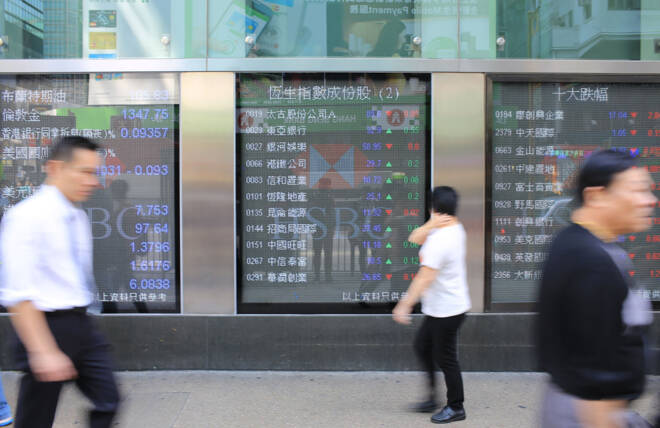Advertisement
Advertisement
Hang Seng Index and Nikkei 225: Divergent Trends Amid US-China Tensions
By:
Key Points:
- Hang Seng Index falls 1.73% as US-China tensions weigh on tech; Tencent plunges 6.99%
- Biden's Section 1260H List escalates US-China trade friction, impacting Hong Kong and Mainland China markets.
- Nikkei 225 surges 2.00% on yen weakness, boosting tech stocks like Tokyo Electron (+10.88%).
US Markets: Nasdaq Rallies as Bitcoin Surges Above $100K
US equity markets had a mixed session on January 6. The Nasdaq Composite Index and the S&P 500 extended their gains from Friday, advancing by 1.24% and 0.55%, respectively. However, the Dow bucked the trend, slipping by 0.06%.
News of the incoming Trump administration targeting critical sectors with tariffs boosted demand for riskier assets. However, Trump denied the reports, calling it fake news, leading to a pullback from session highs.
10-year US Treasury yields dipped on the initial news, with softer tariffs supporting a less hawkish Fed rate path. However, yields ended the session higher, reflecting the influence of tariffs on market sentiment toward the Fed rate path.
Crypto-related stocks fueled the Nasdaq rally amid ongoing speculation about a US Strategic Bitcoin (BTC) Reserve (SBR). MicroStrategy (MSTR) jumped 11.61%, while Marathon Holdings (MARA) gained 4.63%. Bitcoin ended Monday up 3.98%, closing above the $100k level for the first time since December 18.
US Services PMI Signals Softer Fed Stance
On Monday, finalized S&P Global Services PMI data drew interest. The Services PMI increased to 56.8 in December, up from November’s 56.1 but down from a preliminary 58.5.
The December survey revealed easing cost pressures while service providers increased staffing levels for the first time in five months. Softer price trends countered modest employment growth, supporting expectations for a less hawkish Fed rate path.
Lower borrowing costs could boost company earnings and stock valuations.
Biden Administration Targets Chinese Firms
On Monday, January 6, the Biden administration targeted Chinese companies in its final days in office. The administration added several prominent Chinese companies to the Section 1260H List, including Tencent Holdings Limited, China’s National Oil Corporation’s CNOOC, and Cosco Shipping Holdings.
The Section 1260H list contains Chinese companies that the US Defense Department believes work with China’s military.
Brian Tycangco, editor/analyst at Stansberry Research, remarked on the news, saying,
“Today’s China market rout is brought to you by the US Department of Defense. While being included in the Section 1260H list carries a negative perception, it has little impact on the firms’ day-to-day activities. Most likely a bargaining tool by US in light of China’s latest retaliatory strike restricting critical metals exports hurting the MIC.”
Tycangco also commented on US plans to address ideological threats, stating,
“Also, news of reauthorization of US House Select Committee on China hit the wires today. It came with expanded scope to address things like “ideological threats” posed by Beijing. Bottom line: US-China relations not to get better anytime soon, even under Trump’s 2nd term. May get even worse.”
Hang Seng Index Slumps on US-China Concerns
In Asian markets, the Hang Seng Index slid by 1.73% on Tuesday morning. Market sentiment toward the US government’s moves against Chinese firms weighed on Hong Kong-listed stocks.
Tech stocks led the morning losses, with the Hang Seng Tech Index sliding by 2.00%. The Major tech players Tencent (0700) tumbled 6.99%, while Alibaba (9988) and Baidu (9888) posted losses of 1.40% and 1.05%, respectively.
Mainland China-listed stocks also declined further, reflecting concerns about US-China relations. The CSI 300 and Shanghai Composite dropped by 0.19% and 0.38%, respectively.
Nikkei Rallies on Yen Weakness
On Tuesday, Japan’s Nikkei Index rallied 2.00%, with a weaker Japanese Yen driving demand for Nikkei Index-listed stocks. The USD/JPY extended its gains from Monday, rising to a Tuesday high of 158.412 before easing back. A weaker yen supports Japanese exporters by making their goods more competitive and boosting overseas earnings.
Tech stocks led the way, with Tokyo Electron (8035) surging 10.88%, while Softbank Group Corp. (9984) gained 1.25%.
ASX 200 Extends Gains Amid Tech Strength
Meanwhile, Australia’s ASX 200 Index extended its winning streak to four sessions, rising 0.34%. Gold and tech-related stocks contributed to the gains, while mining stocks extended their losses from Monday. The S&P/ASX All Technology Index rallied 1.49%, mirroring the Nasdaq’s gains.
Key movers included Northern Star Resources (NST), which advanced by 0.77% as gold prices moved higher on Tuesday.
However, iron ore spot prices dropped 1.27% on Monday amid demand concerns, weighing on mining stocks. Mining giants BHP Group Ltd. (BHP) and Rio Tinto Ltd. (RIO) ended the session in negative territory.
Outlook
Asian markets face a pivotal period, with several key factors in focus:
- US-China Relations: Tariff developments could weigh on Chinese exports and ripple through China-dependent economies like Australia.
- US Labor Market Data: Strong data may pressure rate-sensitive sectors such as tech and real estate by influencing the Fed’s rate path.
- China’s Stimulus Measures: Efforts to support domestic demand may help offset the drag from weaker global trade.
Market sentiment remains fragile, with risks tied to global trade tensions and monetary policy shifts. Explore how these developments might influence your portfolio here.
About the Author
Bob Masonauthor
With over 28 years of experience in the financial industry, Bob has worked with various global rating agencies and multinational banks. Currently he is covering currencies, commodities, alternative asset classes and global equities, focusing mostly on European and Asian markets.
Did you find this article useful?
Latest news and analysis
Advertisement
